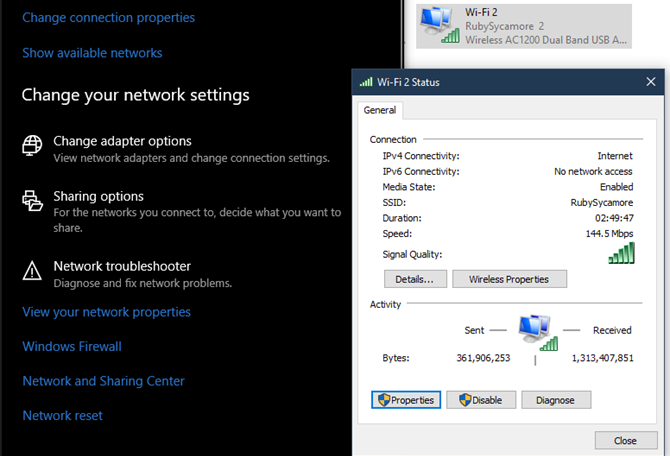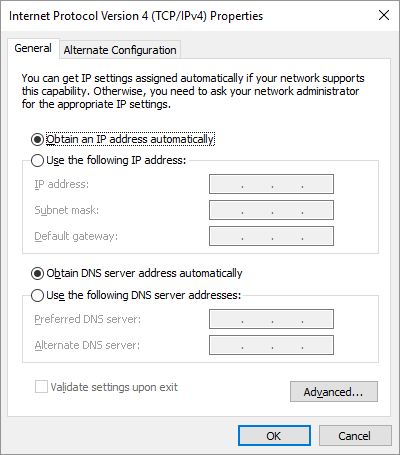
Seeing the “Wi-Fi doesn’t have a valid IP configuration” error in Windows 10? This problem is frustrating since it prevents you from going online.
We’ll explain why you see the message that Wi-Fi doesn’t have a valid IP configuration and how to fix it so you can get connected again.
What Is an Invalid IP Configuration?
Before we dive into the fixes, it helps to know a bit about why this error appears. In short, when you connect to Wi-Fi, your router assigns an IP address to your computer so it can get online.
If something goes wrong with the IP configuration, your computer and router won’t be able to communicate. For instance, your computer might try to use a different IP than the router expects it to. This prevents you from reaching the internet, and results in the “doesn’t have a valid IP configuration” error.
Let’s look at how to resolve this issue.
1. Restart Your Computer

Like most issues, your first troubleshooting step should always be to restart your computer. You might be seeing the “Wi-Fi doesn’t have a valid IP configuration” message due to a temporary hiccup. Before you spend time on more intensive fixes, you should perform a quick restart to begin from a clean slate.
If you reboot and still see this error, continue on.
2. Reboot Your Router
The other simple fix for networking issues is to restart your wireless router. Because this error involves the router handing an IP address to your computer, it may have run into a problem. Like rebooting your computer, a quick router restart will clear out any short-term glitches and let it start anew.
If you still can’t get online after a power cycle of all equipment, we’ll next look at more advanced steps.
3. Release and Renew Your IP Address
Using a Command Prompt tool, you can give up your computer’s current IP address and request a new one. This is a good way to clear up the invalid IP configuration issue.
To do this in Windows 10, right-click on the Start button or press Win + X to open the Power User menu. Select Command Prompt (Admin) or Windows PowerShell (Admin) from the list to open a command line.
At the command line, type the following and press Enter:
ipconfig /release
This tells your computer to release its current IP address back to the router’s pool of available addresses. Next, enter this command (press Enter to send it) to request a new address:
ipconfig /renewWith your new IP address, try to get online again.
4. Reset Network Protocols
Continuing on, you can also use the command line to reset the Winsock, which is the specification that details how your computer accesses the network.
Open an administrator Command Prompt or PowerShell window as described above, then run the following commands one at a time:
netsh winsock resetnetsh int ip resetTry to get online again afterward.
5. Check for a Manual IP Address Setting
By default, your computer and router use a protocol called DHCP (Dynamic Host Configuration Protocol) to assign an IP address to your system without any manual intervention. If you’ve set a static IP address in the past and something changed, this can cause the “Wi-Fi doesn’t have a valid IP configuration” error.
To check for this, open Settings (the Win + I shortcut is handy) and browse to Network & Internet > Status. Here, select Change adapter options. In the box that appears, double-click on your Wi-Fi connection.
You’ll see a new window containing information about your connection. Click Properties at the bottom, then double-click Internet Protocol Version 4 from the list of options. This will open the properties window, where you can change IP settings.

Most people should have the Obtain an IP address automatically button selected. If you have Use the following IP address enabled with addresses listed below, try changing this to automatic and hitting OK. Then see if you can get online with this change.

Setting up a static IP address could help solve this problem, but it’s probably not necessary and overkill for most users.
6. Update Your Wireless Driver
Since this “Wi-Fi doesn’t have a valid IP configuration” error involves a wireless connection, you should make sure the driver your computer uses for Wi-Fi is working properly.
To do this, press Win + X again and select Device Manager. Expand Network adapters and find your wireless driver listed. Right-click it and choose Update driver > Search automatically for updated driver software.

This may not find a new driver. In that case, you can instead right-click the device name and choose Properties to see who manufactured it (chances are it’s Intel or Realtek). You may be able to find an updated driver version on the hardware provider’s website; see our guide to updating Windows drivers for help with this.
Failing that, you can right-click the wireless device and choose Uninstall device to remove it from your computer. When you reboot, Windows should reinstall a new wireless driver. However, if it doesn’t do this automatically, you’ll need to reinstall it yourself, either using another computer or a wired connection.
7. Check for Malware and Antivirus Interference
If you’ve reached this point, it’s worth running a scan for malware on your computer. Viruses and other malicious programs can sometimes mess with your internet settings to prevent you from getting online. While it may not result in this particular “doesn’t have a valid IP configuration” issue, it’s still worth a try.
Run a scan with Windows Defender or another antivirus you have installed on your system. If you have access to another computer that can get online, download the free version of Malwarebytes and copy it over to the affected computer to run an anti-malware scan.
As another troubleshooting step, try disabling your antivirus and trying to get online again. Some third-party antivirus programs can interfere with normal network operations and block your network connection.
8. Increase the Number of DHCP Users

Most routers have a default limit on the number of devices that can connect using DHCP. If you have lots of online devices in your home, there’s a chance that you’ve hit this limit, which is causing the “Wi-Fi doesn’t have a valid IP configuration” error when your computer tries to get an address.
You’ll need to log into your router, find the DHCP settings, and increase the limit to fix this issue. How to do this will depend on your router, so we can’t provide exact instructions. For a start, see the basics of logging into a router, and consult your user manual if you need more specific help.
9. Reset Network Settings

At this point, you’ve tried the major fixes. You should now reset your Windows 10 network settings, as there may be a deep-rooted issue.
Visit Settings > Network & Internet > Status and click Network reset at the bottom of the page. Note the warning that doing this will remove all your network adapters and reset everything back to the defaults. If you’re OK with that, click Reset now. The process will restart your PC.
IP Configuration Errors No More
Hopefully you didn’t need to reset all your network settings to resolve the “Wi-Fi doesn’t have a valid IP configuration” message. This error is usually a temporary glitch that goes away with one of the early steps.
If you’re still having a problem or want to learn more about home networks, have a look at our full guide to Windows network troubleshooting.
Read the full article: Fix the “Wi-Fi Doesn’t Have a Valid IP Configuration” Error Now
Read Full Article
No comments:
Post a Comment